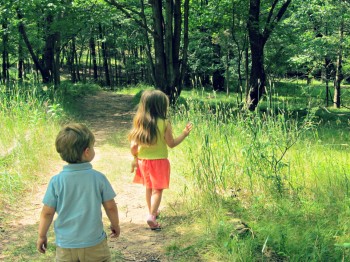 |
| Children interacting with nature. |
Think back to our past when there weren't PowerPoint presentations and video clips to document what amounts to a visual, and audio experience. When John Muir, the great documenter of nature, was a boy, nature was right outside his home. He could be companion with the frogs and explore what happens in bird nests. He said about the immediacy of nature: "The sudden plash into pure wilderness - baptism in Nature's warm heart - how utterly happy it made us! Nature streaming into us, wooingly teaching her wonderful glowing lessons, so unlike the dismal grammar ashes and cinders so long thrashed into us....Young hearts, young leaves, flowers, animals, the winds and the streams and the sparkling lake, all wildly, gladly rejoicing together!"
Nature in the rough and raw, encountered and discovered on our own, as we walk along and blaze our own trails. presents opportunities for pure joy. But it's not easy having that experience when we're surrounded by concrete and we're lucky if there's a park nearby. We may not be all that comfortable encountering nature on its own terms, but more so when presented to us as a program. But do we really encounter nature in all its glory? Must we keep our hands off?
Here, Harvard entomologist E.O. Wilson describes his early encounters with the nature of his youth, "I hunted reptiles: stunned and captured five-lined skinks with a sling-shot, and learned the correct maneuver for catching Carolina anole lizards (approach, let them scuttle to the other side of the tree trunk and out of sight, peek to see where they are sitting, then take them by grabbing blind with one hand around the trunk). One late afternoon, I brought home a coachwhip snake nearly as long as I was tall and walked into the house with it wrapped around my neck." Yes, in childhood, even those who fought to preserve wildlife had experiences of capturing some of the animals around them for a further look when they got home. Of course, back then, there wasn't as much of a concerted effort to preserve animal species, as there is today, but does that truly mean hands off nature?
 |
| Surprise! An encounter with a waterfall. |
 |
| A wonderful discovery on a nature walk! |
Click here: GET PAID TO CAMP

















































